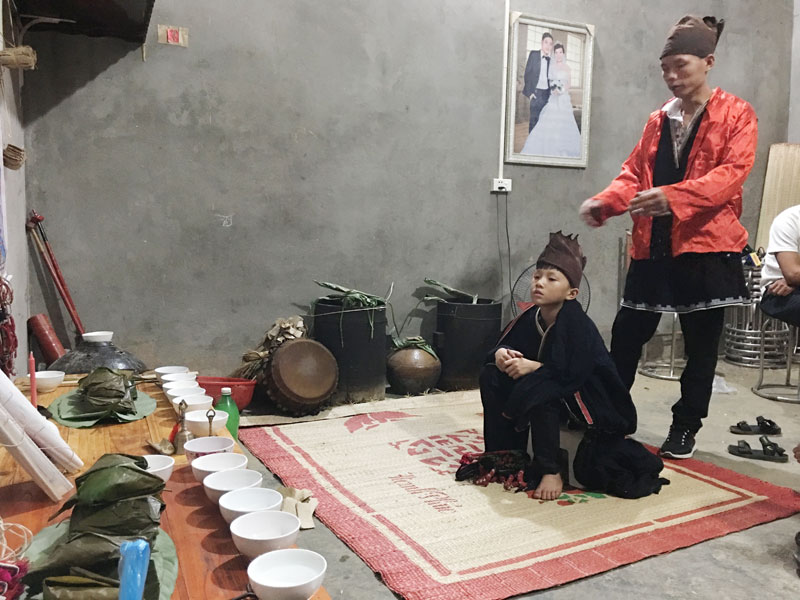


 A boy of Dao Tien ethnic group (Da Bac
district) in Lap Tinh ceremony to be recognized as an adult.
A boy of Dao Tien ethnic group (Da Bac
district) in Lap Tinh ceremony to be recognized as an adult.
Lap Tinh ceremony is a happy day for the family, the lineage and also for the whole village. There must have a big pig, a rooster, wine, rice, sour meat, Day cakes, Chung cakes, the incense, the underworld money, the worshiping paintings, formal uniforms etc. At the same time, two main priests, one auxiliary priest must be invited, 3 maids and people participating in the dance have to be invited, too. To conduct the ceremony, the homeowner must prepare at least 2 pigs, chickens, white wine and rice to eat for the holidays (now it depends on the economic conditions of each house to prepare accordingly so that the burden on the host family can be avoided).
Lap Tinh ceremony is held within 1 day 2 nights. Before the ceremony, the baby is to be named and the father have to go on a vegetarian diet for 10 days to boycott. At exactly 12 o'clock in the first night of the ceremony, the priest begins the ceremony of worshiping saints, tutelary gods and crowns to ask for permission to name. The baby is placed in the chair in front of the altar, the two chief priests and his father place three candles on the head and shoulders, then walk around the child, reading the ancient books of Dao ethnic people, including 24 or 36 chapters and articles of the Dao which command the children to get rid of the bad, the ignorance, keep the good and kind in the body of the named baby. The new name is given at 1 o'clock, at this time the baby is recognized as an adult and has a place in the clan and community.
The ceremony is witnessed by the neighbours, who attended to congratulate the named child. They wish the child a healthy, long life, happiness, and have sufficient children. After that, the sounds of drums, gongs, flutes, horns and bells signal the beginning of the ceremony. At this time, the ritual and the child dance continuously until morning. Everyone sings and dances, it's called Chao Cheo singing. Chao Cheo singing is not sung anywhere, only at Lap Tinh ceremony. It is a dance that invites the ancestors to witness.
On the second day, 2 pigs are put on the table to worship. At night, the rituals take turns to read the worshiping songs. Sĩ people including 3 men and 3 women dance and sing together. This is a ceremony to see off the ancestors and the forest ghost. At the end of the ceremony at 12 p.m on the second day, the family split the pork into a lot of equal parts to offer to the rituals together with the maids and guests coming to congratulate.
Lap Tinh ceremony of the Dao Tien ethnic people has profound human meaning, containing a lot of positive values, aiming at educating and reminding children to always turn to the origin, and at the same time it contributes to conserving, preserving and promoting the cultural identity of the Dao ethnic people.